This gluten free challah bread is rich, golden, slightly sweet, and soft. It's not just for Jewish holidays anymore!
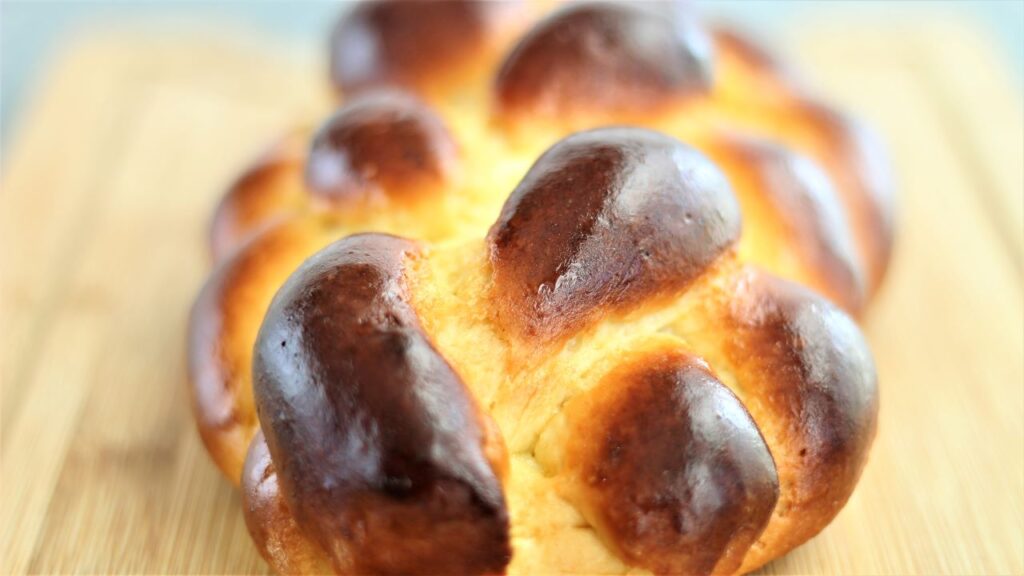
I've been working on perfecting this gluten free challah bread for at least a few years now. When I get an idea in my brain, sometimes it's really hard for me to let it go. But through all my trials and failures, I have to keep posting successful recipes or you'd never see a thing from me! That's why it often takes me many, many months (or years even) to create a new bread recipe.
Prior to my gluten free days, I had the best challah that I haven't been able to stop thinking about. It was so good that my kids and I sat there and polished off the entire loaf within a couple of hours! In our defense, it was a smaller round turban-like loaf. But still.
What is Challah?
Challah is an egg-rich bread that's golden and soft. It's a Jewish traditional bread that's eaten on Shabbat and many other holidays (except Passover, when leavened bread is not allowed). Challah holds a spiritual meaning in the Jewish community.
But this bread has made it into the mainstream and is now available in bakeries and grocery stores. I'm not Jewish, but I love challah and have been craving it for years.
Gluten Free Challah Dough
Making gluten free challah dough is similar to the dough for my gluten free Hawaiian rolls. Instead of using dairy, we'll use nondairy alternatives (in the Jewish faith, meat and dairy aren't eaten together at the same meal):
- Kim's gluten free bread flour blend -- instead of using whey protein isolate, use one of the dairy free alternatives I've listed.
- Sugar -- there is a lot of sugar in this recipe. Don't be alarmed. The amount of sugar coupled with the amount of yeast means that most of the sugar is actually turned into carbon dioxide. Also, this recipe makes two large loaves. You can attempt to reduce the sugar, but you may not get the same soft results.
- Pysllium husk powder -- really helps with the elasticity of the dough, which is crucial to braiding.
- Baking powder--I've found adding just a little bit of baking powder in gf yeast breads helps give them a boost.
- Salt--helps with flavor, but also with fermentation (rise).
- Water--instead of milk typically used in enriched breads, we're using water here to keep the bread dairy free.
- Oil--again keeping the recipe dairy free. You can use canola, vegetable, etc.
- Eggs--the original recipe calls for 2 eggs, but to be true to challah, I've added one additional yolk for extra richness.
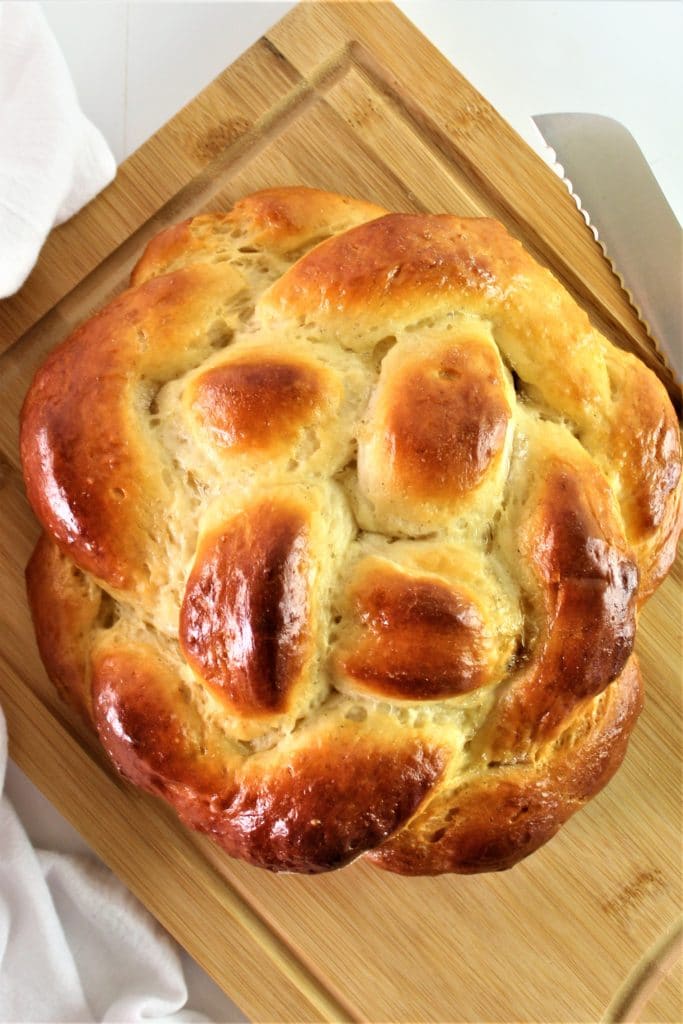
Braiding Methods
I only watched about 50 videos on YouTube for how to braid challah. And every time I'd start doing it myself, I'd forget what went where, haha! Then I found one video that I felt I'd remember so that's what I stuck with. It's a 4 strand round braid. But I also made a 4 strand long loaf just to make sure I could do it!
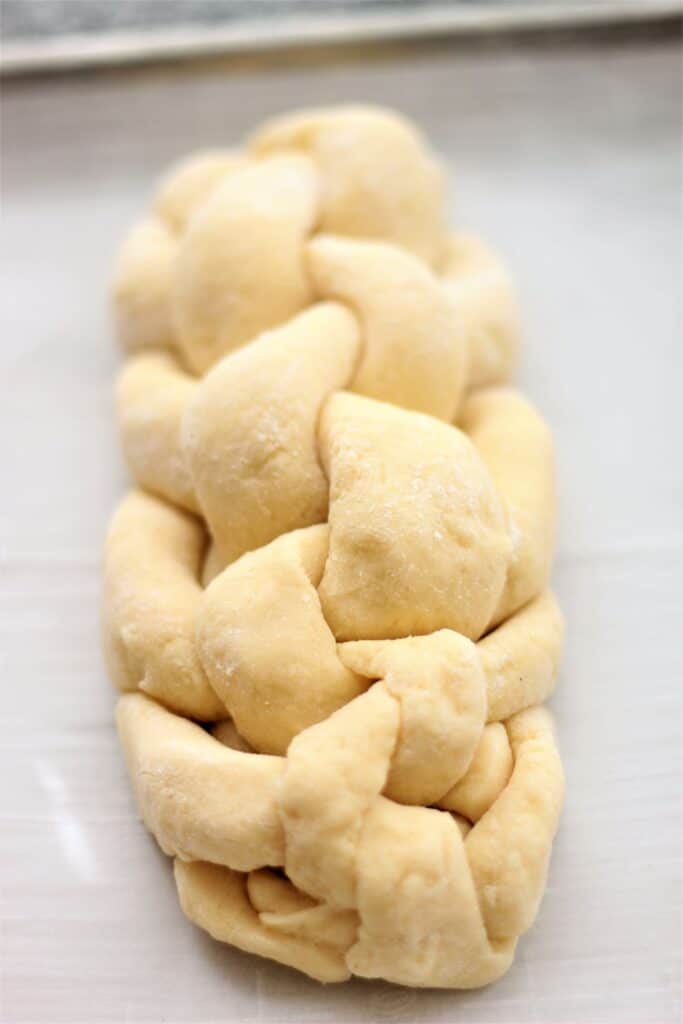
Rosh Hashanah is coming up and from what I've read, round loaves of challah are traditional during this Jewish holiday because they symbolize eternal life or the circle of life. I'm not Jewish and don't profess to know much of anything about the faith, so please consult someone who knows more than I do for the real meaning, such as a rabbi.
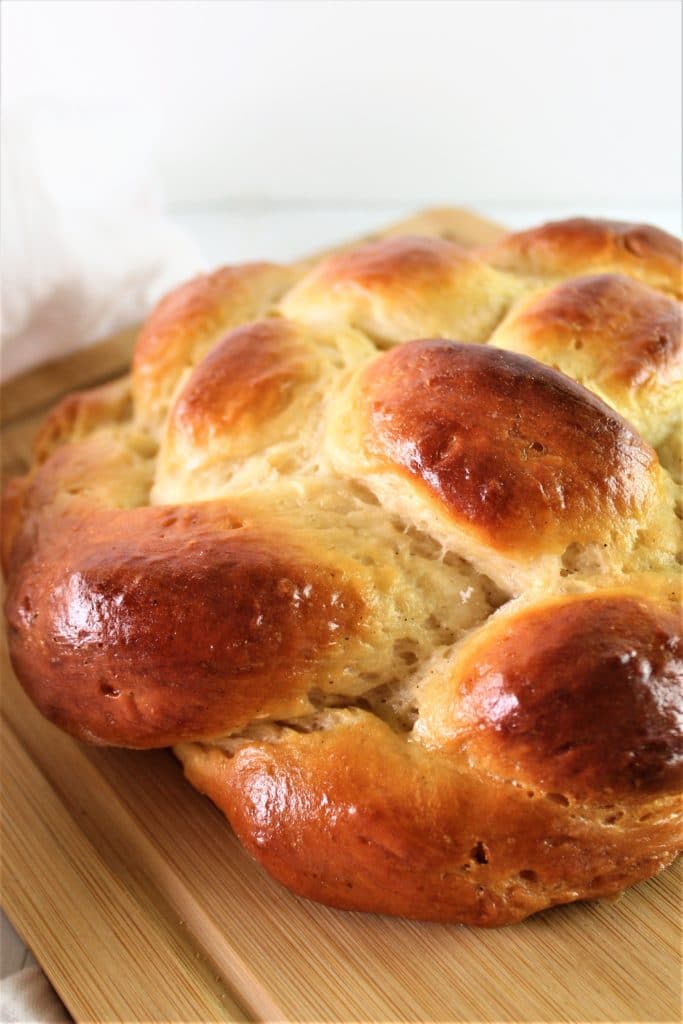
Brush Three Times with Egg Wash
Instead of covering the loaves of challah while letting them rise, brush them with an egg wash. This will create a protective shield while they rise and hydrate the skin so it doesn't dry out.
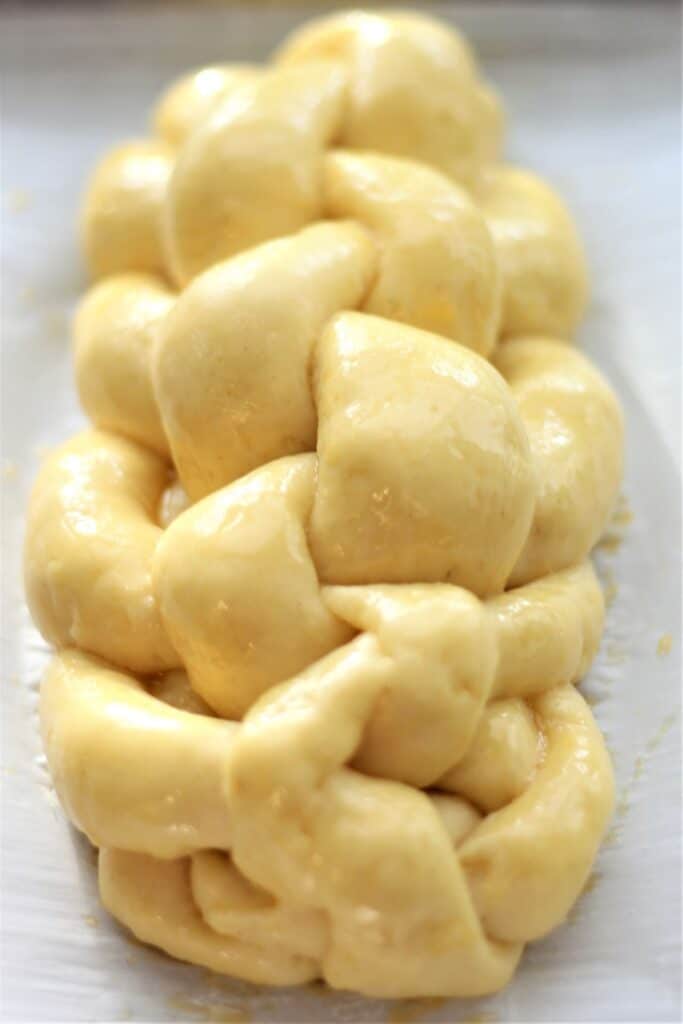
Allow the challah to rise in a draft-free area until almost doubled in size, anywhere from 30 minutes to an hour and a half. I always put my proofing loaves in my oven that's been heated briefly on the "warm" cycle (about 170 degrees F) and then turned off.
When they're almost fully proofed, remove them from the oven and preheat the oven to 375 degrees F. Brush them with another layer of egg wash before popping them in the oven. Immediately drop the temperature down to 325 degrees F and bake for about 40 minutes. Remove halfway through baking time (at 20 minutes) to brush any newly risen (un-brushed) areas with egg wash.
Tips for Making the Best Gluten Free Challah Ever!!
- Make sure your dough is COLD!! It really is easier to braid if you have properly chilled dough. If you find that your refrigerated dough isn't cold enough, put the dough in the freezer for about 15 minutes (covered) before braiding.
- You don't have to be absolutely precise when braiding. We're not using stretchy dough like the people I've watched braid "real" challah, so it's okay if you tuck a good amount underneath. And anyway, tucking some underneath at the ends and lifting the dough up to do so will increase the height of the bread as it will rise up and not out.
- Practice makes perfect. I'm still learning about how to braid these loaves, so if I don't get it right, I start over (smush the dough back together and roll out yet again).
- Don't skimp on the egg wash. It's what gives that shiny and golden crust!
- The dough can be left in the fridge for a few days (3 at most). Make one loaf one day to eat fresh and another loaf another day so you'll have a perpetual loaf of fresh bread for days!!!
- Leftovers make GREAT French toast, bread pudding, or an overnight French toast bake. The challah will need a little more time soaking up the custard, though, so make sure to leave it in longer than you normally would.
- You can freeze leftovers as well. Best practice is to slice individual slices, flash freeze on a baking sheet until solid, and put slices in ziptop baggies with as much air as possible removed. Thaw a couple slices at a time.
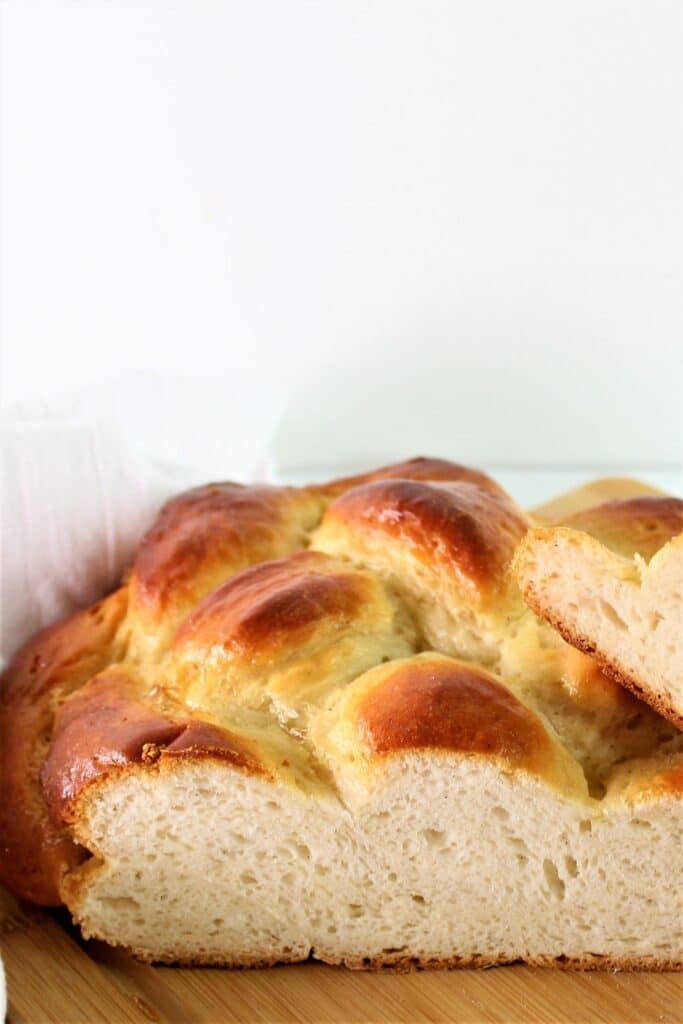
Whether you're Jewish or not, you're going to LOVE gluten free challah bread! It's eggy, rich, soft, and slightly sweet, and it's perfect for any time. If you have leftovers, make french toast!
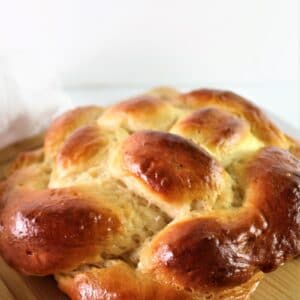
Gluten Free Challah Bread
Ingredients
- 3½ cups (495g) Kim's gluten free bread flour blend* (made with dairy free protein powder)
- 2 tablespoon psyllium husk powder
- 1 cup (200g) granulated sugar**
- 1¾ teaspoon baking powder
- 2 tbsp plus 1½ teaspoon (24g) instant (rapid rise) yeast, not active dry
- 1 teaspoon kosher salt
- 1¼ cups (300ml) water
- ½ cup (120ml) canola or vegetable oil
- 2 large eggs, plus one egg yolk
- 1 large egg combined with a pinch of salt and 1 tablespoon of water for the egg wash
Instructions
- In the bowl of a stand mixer, whisk together the flour blend, psyllium husk powder, granulated sugar, baking powder, yeast, and kosher salt.
- Turn the mixer, fitted with the beater blade, on low and slowly pour the water and oil in. Add the eggs and egg yolks and blend until well combined.
- Switch to the dough hook and turn the mixer up to medium high speed and mix for 5 minutes. Scrape the dough from the sides of the mixer bowl and heap it in the middle of the bowl (or place it in another bowl) and cover.
- Allow the dough to cold rise in the refrigerator for at least 4 hours, preferably overnight or up to 3 days.
- On baking day, remove the dough from the refrigerator and knead until smooth, adding more flour blend as necessary. Cut in half to make two loaves (or put the other half in the fridge for another day).
- Roll the dough out to a small rectangle (size isn't important-it should be roughly ½ to ¾ inch thick). Cut dough in half and then in half again to create 4 strands. Roll these strands on the counter to smooth them out into rope shapes.
- Begin braiding by making a hashtag sign and then crossing one over and the other under, as shown in the video. Then move the strand that's under on one side over its "neighbor" and keep going around in a circle until all those strands that were under are now over their "neighbors". Then go in the reverse direction until all strands have been crossed. Tuck under any stray strands.
- Place loaf on parchment-lined baking sheet and brush with egg wash. Put in a warm, draft-free area to rise until almost doubled, about 30-45 minutes (depending on the warmth of your area).
- Preheat the oven to 375° F and brush the loaf again with egg wash. Place the loaf into the hot oven and immediately turn it down to 325° F. Bake for 20 minutes. Pull out the partially baked loaf and brush any light areas (or all over) again with the egg wash. Bake for another 20 minutes.
- Remove from the oven and allow to cool before cutting or tearing into loaf. Loaf will remain fresh for about 24 hours. To reheat it or to "freshen" it up, wrap the loaf or pieces in foil and place in a low oven (325° F) for 10-15 minutes.
Notes
Braiding method adapted from Jamie Geller's 4 Strand Round Challah

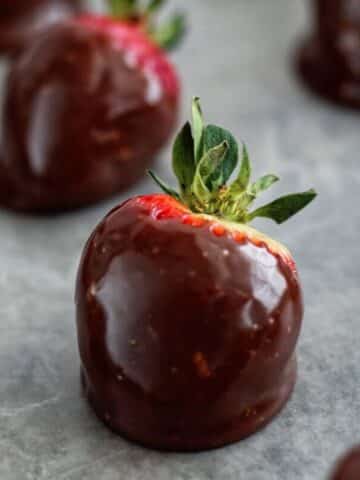
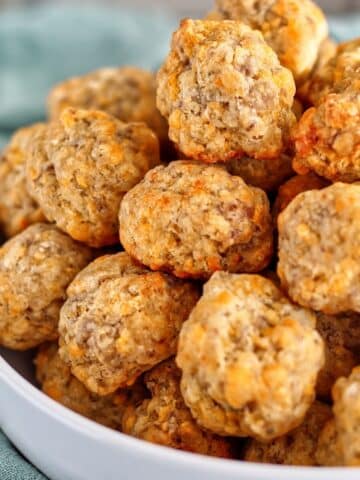
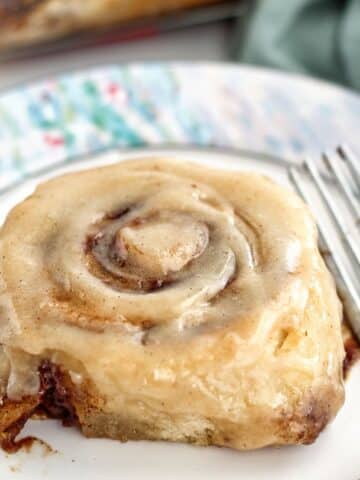

Yvonne Stevens
I used "Krusteaz Gluten Free All Purpose Flour" for the Challah and even though the dough rose over night, the dough was sticky and did not hold its shape after breading and was very flat. What is the difference to bread flour?
I assume I cannot buy your bread flour, correct? Is it possible to use King Arthur's Bread Flour instead?
Thank you!
Kim
I'm working on selling my flour blends, but until then the recipes are on the blog. Normal gf flour blends won't work, but I'm not sure about the new KA bread flour blend. You could try it.
Louise
I Love Love Love this recipe. Have been looking for a Chullah recipe that I can actually eat and enjoy! This hits the spot exactly. Tastes just like the Chullah I remember as a young person (I'm 76 YO!) You have made my day and I will pass along the link to my son who is now GF as well.
I did make some modifications, as I only had Active Dry Yeast - added it to the water, along with 2 Tbsp of coconut sugar, Then after it foamed up, I added the physillium husk powder and let it sit until it jelled. Then added that into the dry mix in my stand mixer. It worked out great.
I also used a cup of coconut sugar, as I do not use granulated sugar. The loaves turned out brown, but colour means nothing, it's the taste and texture that is needed, and it does that perfectly.
Made this for company coming tonight (older sister and her husband). It will be interesting to know what she thinks as we grew up eating Chullah a lot.
Thank you Kim, so very much for all you do.
Another of your commentors said they would buy your book if you ever produced one - I would also.
Blessings.
Joann Dardick
Tomorrow, I am going to make a double batch of challah ( enough for 4 loaves). Can I put all of that dough batch together in the refrigerator in a covered bowl? My family loves this challah — even the kids who don’t have celiac disease!